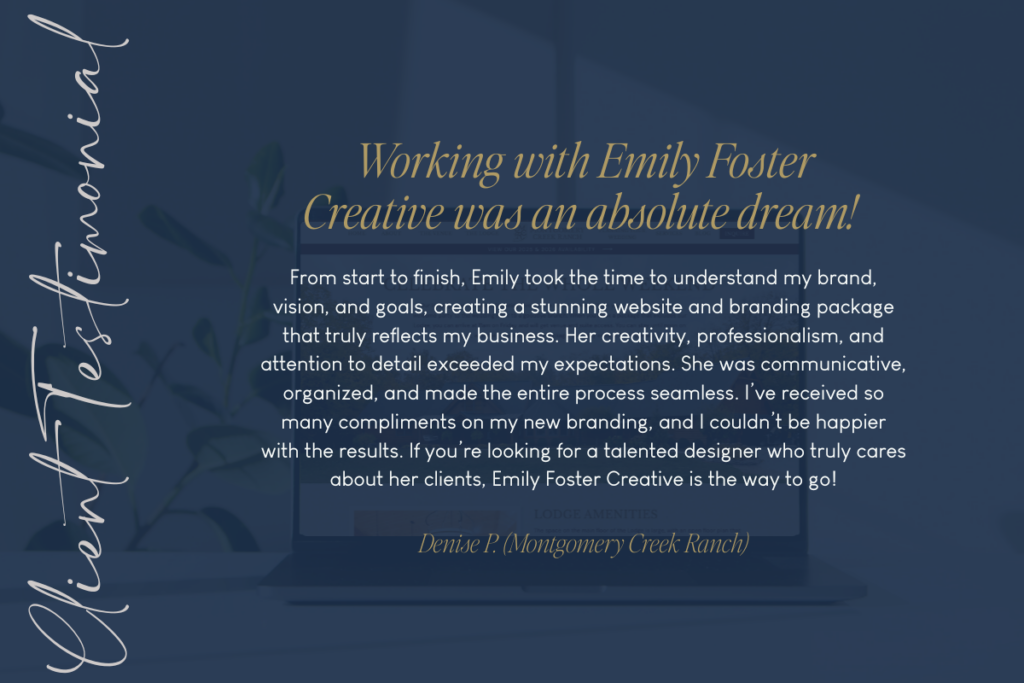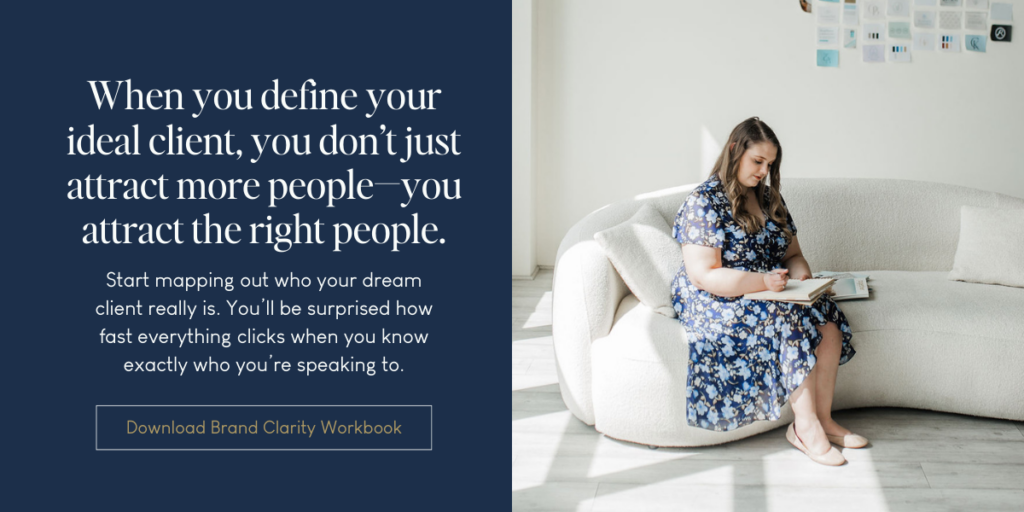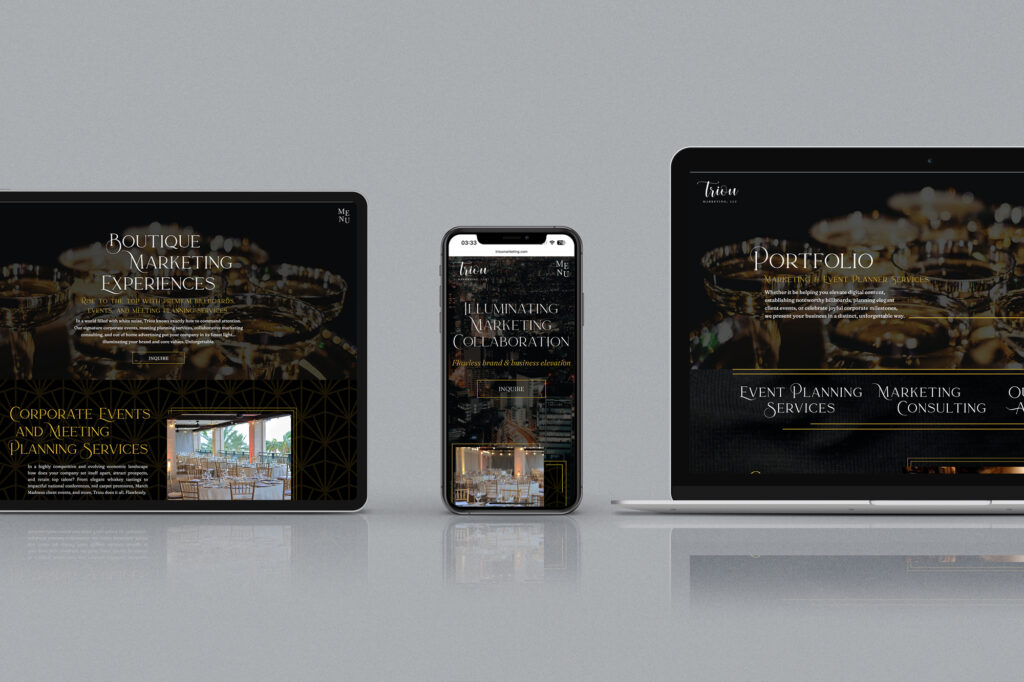How to define your ideal client is one of the most important steps you can take as a wedding or event professional ready to grow a standout brand. It’s not just about narrowing your audience—it’s about showing up with clarity, attracting the right people, and building a business that feels as good as it looks.
You didn’t get into this business to blend in. You’re not here to work with everyone—you’re here to serve people who see your value, respect your process, and light you up creatively. But that kind of alignment doesn’t happen by accident. It starts with intentionally defining who your business is built for. Without this clarity, your brand strategy falls flat, your content feels generic, and your marketing becomes a chore instead of a magnet.
Whether you’re one year or fifteen years in, revisiting your ideal client is never a waste of time. And if you’ve been feeling stuck, burnt out, or like you’re attracting the wrong people—it’s probably time to pause and do this work. The good news? Once you’ve clearly defined your ideal client, you can build everything else—your messaging, your visuals, your pricing, your packages—around what truly matters to them. Let’s dive in.
🎧 Listen to the full podcast episode here, or tune in on Spotify or Apple Podcasts.
Why Knowing Your Ideal Client Changes Everything
Let’s be real: when you try to speak to everyone, you end up connecting with no one.
Defining your ideal client isn’t fluff—it’s foundational to everything from your brand strategy to your pricing, marketing, and the kind of clients you attract. As wedding and event pros, you’re not selling a physical product. You’re selling trust, vision, creativity, and experience. That’s why knowing exactly who you’re serving helps you speak their language, solve their problems, and build real connections.
When I started my business over four years ago, I didn’t know who my ideal client was. I said yes to everyone. And while I learned a lot, that season of serving “everyone” made everything—from writing Instagram captions to networking—so much harder.
Once I understood who my dream clients were, everything got easier: content flowed faster, pricing felt aligned, and the people who found me were already halfway sold because they felt seen.
What Is an Ideal Client?

Your ideal client—sometimes called a dream client, client avatar, or target customer—is the person you’d love to work with again and again. They’re the ones who energize you, pay you what you’re worth, respect your process, and genuinely enjoy the experience of working with you.
Some people think ideal clients are unicorns—rare, elusive, hard to find. But I believe there are more of them out there than we realize. The key is getting specific. You don’t need to attract everyone getting married or planning an event. You just need to attract the right ones, over and over again.
Your ideal client may look like a mix of your past best clients. Maybe you loved how one couple trusted your vision, how another was highly organized, and how a third never questioned your pricing. When you start to see those patterns, you can begin to build your client profile around the traits that matter most.
Why You May Not Know Your Ideal Client Yet—and That’s Okay
Especially in the early days, it’s totally normal to serve a wide range of clients. That season of “taking on what comes your way” can be incredibly valuable—it gives you real-world insight into what you like, what you don’t, and who you thrive with.
You don’t need to define your ideal client on day one. But if you’ve been in business for a year or more and still feel like your marketing isn’t landing or your offers aren’t being valued, it’s time to pause and define who you really want to serve.
No matter how long you’ve been in business, it’s never too late to revisit and refine your client personas. Especially if you’re pivoting or raising your prices, knowing who you’re talking to becomes even more important.
Primary vs. Secondary Clients
You likely have more than one ideal client. That’s normal. Many of us offer a range of services, and each one may attract a slightly different person.
Your primary client is the one you want to book most often. They’re aligned with your signature offer and your highest vision. For example, if you’re a wedding planner who loves full-service design and logistics, your primary client is the one looking for the whole package—not someone looking for a month-of coordinator.
Your secondary clients are still a good fit. Maybe they book your partial planning or coordination services. They’re not your main focus, but you still enjoy working with them—and they might grow into your primary client in the future.
Defining both groups helps you speak directly to them in your marketing, so you can guide them to the offer that’s best for them.


The Two Key Lenses: Demographics and Psychographics
To define your ideal client, you need to look through two lenses: demographics and psychographics.
Demographics are the surface-level details: age, income, location, job title, relationship status, and family background. These are helpful for understanding what your client can realistically invest and what stage of life they’re in.
Psychographics go deeper. They reveal what your clients care about—what they value, what keeps them up at night, and what gets them excited to spend money. This is where the magic happens.
Ask yourself:
- What are their values?
- How do they make decisions?
- Are they more detail-oriented or big-picture?
- Do they crave creativity or structure?
- Are they used to luxury services or do they like a more DIY approach?
If your ideal client shops at Target and gets Starbucks every weekend, what does that say about their priorities? Maybe they value convenience and small luxuries. Maybe they like brands that feel friendly and polished. That gives you insight into how you should present your business to them.
Real Talk: They Need to Be Able to Pay You
Your ideal client isn’t just someone you vibe with—they also need to afford your services.
It doesn’t mean they’re millionaires, but they do need to be able to invest without stretching themselves so thin that they resent it. If someone constantly tries to negotiate or talks you down, they’re likely not your ideal fit.
Ideal clients don’t hesitate when they see your value. They say, “This is exactly what I’ve been looking for.” And they mean it.

They Have a Problem You Can Solve
At the core of every good brand is this: you solve a real problem for someone.
Your ideal client knows they can’t DIY it anymore. They don’t want to cobble together a Pinterest board or manage a vendor team alone. They’re craving clarity, ease, professionalism, and something they can’t get anywhere else—you.
If you clearly communicate how you solve their specific problem, your marketing becomes magnetic. That’s what defining your ideal client allows you to do.
They Make the Work Easier (Even if the Work Isn’t Easy)
Even if your work is complex, it doesn’t need to feel heavy. Dream clients trust you. They ask thoughtful questions but don’t micromanage. They respect your timeline, follow your process, and respond to your emails. They’re not perfect (no one is), but they make the experience better—not harder.
That’s a sign you’ve found the right people.

Examples From My Own Brand
When I first started, I said yes to e-commerce businesses, therapists, life coaches—everyone. And while I served them well, I realized I wasn’t feeling creatively fulfilled. I wanted to work with people in the wedding and event space. People who saw design not just as something pretty but as something purposeful.
Now, my ideal client is a wedding pro who’s been in business for a few years, has outgrown their DIY branding, and is ready for a website that truly reflects their talent. They’re busy but thoughtful, strategic but creative. And they’re ready to invest in something that will grow with them.
I also work with secondary clients—people who may be newer or have a smaller budget. They might choose a smaller package or a template customization. I still love working with them. Sometimes they come back later for a full rebrand when they’re ready.

Mistakes to Avoid When Defining Your Ideal Client
- Being too vague – “Couples who want a beautiful wedding” isn’t specific enough. What kind of beautiful? Do they want elegant and timeless or quirky and bold?
- Focusing only on income – Money matters, but values matter more. Someone with a smaller budget might still be a great fit if they prioritize your service.
- Assuming you only get one – You can have primary and secondary clients. Just make sure your offers are aligned for each group.
- Thinking you can skip this – Even massive corporations never launch a campaign without defining the audience first. You shouldn’t either.
Your Ideal Client May Shift Over Time—That’s Normal
One of the most empowering things to realize is that your ideal client can evolve. As you grow in experience, raise your prices, or shift your services, the type of client you want to attract may look different than it did a year or two ago.
Maybe you started out as a day-of coordinator and now you’re craving full-service, high-budget weddings. Or perhaps you once offered branding to all creatives, but now you want to work solely with florists and wedding planners. That’s not a pivot failure—that’s brand clarity deepening over time.
Allow yourself the freedom to re-evaluate. If you feel disconnected from your current inquiries, ask yourself: are they truly the people I want to serve now? Or am I still marketing to the version of my ideal client I had three years ago?
Your brand should grow with you. So if you’re raising your prices, leveling up your services, or niching into something new, your ideal client should reflect that change. Go back and rework your personas when your business shifts direction—and don’t be afraid to get specific again.
Ideal Clients Also Shape Your Brand Aesthetic
Let’s talk visuals. Your logo, color palette, website design, and even your Instagram grid should align with the preferences and expectations of your ideal client.
This doesn’t mean you have to become someone you’re not—but it does mean understanding how your brand looks through the lens of your dream client. If you want to attract editorial-style couples planning luxury weddings, your branding shouldn’t feel too playful or DIY. If you love serving joyful, laid-back clients who value color and personality, your website shouldn’t feel like a black-tie gala.
Your ideal client has visual preferences, too. They’re subconsciously evaluating whether your brand feels like a fit. Do your colors match their vibe? Is your photography curated in a way that aligns with their taste? Does your language match their tone?
If your brand doesn’t look like it’s made for them, they may pass you by—even if you’re a perfect fit otherwise.
This is why it’s so helpful to define your ideal client before diving into brand visuals. Otherwise, you risk creating a beautiful brand that speaks to the wrong person.
Action Steps to Define Your Ideal Client
- Review past clients – Who have you loved working with? Who drained you? Take notes.
- Create separate personas for each offer – Full-service clients and coordination clients likely have different needs and buying triggers.
- Use psychographics to get emotional – What does your client dream about? Worry about? What would they Google at 2 a.m.?
- Talk to real people – Conduct a few market research chats. Ask what made them invest. What did they love about their vendor experience?
- Download the Brand Clarity Workbook – It has every question I ask my own clients when we’re building their brand strategy.
Final Thoughts
You don’t need a million clients. You need the right ones.
The clients who value your creativity. Who trust your process. Who rave about you when it’s all over and send their friends your way. That kind of brand love isn’t random—it’s the result of getting really clear about who you’re here to serve.
🎧 Want more? Listen to the full podcast episode here, or tune in on Spotify or Apple Podcasts.
And if you’re ready for a rebrand that speaks directly to your dream clients, head to my contact page and let’s start your brand strategy journey.
Leave a Reply Cancel reply
We respect your privacy.
Copyright Emily Foster Creative, LLC. 2021 - 2025. All rights reserved.
hello@emilyfostercreative.com
Brand photography by Lena Crocker Photo, Ciara Corin Photo, Moon & Honey Photography and Enliven Photography
Powered by podcasts and tea.
Designing out of Portland, Oregon for creatives around the world.

Be the first to comment